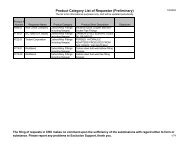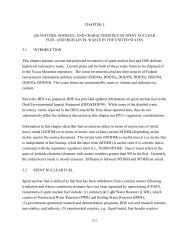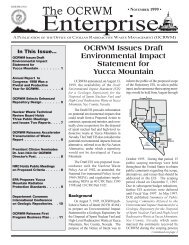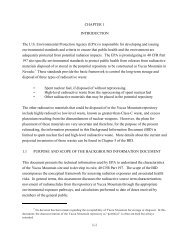E-Commerce Commission Press Kit
E-Commerce Commission Press Kit
E-Commerce Commission Press Kit
Create successful ePaper yourself
Turn your PDF publications into a flip-book with our unique Google optimized e-Paper software.
oadcasting by 2006. 34 With digital broadcasting, TV viewers will be able to interact with theirtelevisions and surf the Web, pay bills, plan a weekend trip, or make dinner reservations.Already, satellite dishes and signals carried over cable television lines enable consumers to receivedata from the Internet through their TVs and television programming through their personalcomputers. At speeds of 10 million bits per second, a household connected to the Internet via acable modem can download a 3.5-minute video in 8 seconds. 35 In most cases today, however, theoutgoing communication (the speed at which the Internet receives the commands by the user) isstill limited to the fastest modem speeds that copper telephone wires will support.Two-way cable traffic would be much faster, but only 9 percent of the 103 million cablesubscribers in the U.S. and Canada (9 million homes) live in zones where two-way cableconnectivity exists. And, only a small number of them—111,000—have actually subscribed to theservice. By 2000, analysts estimate that two-way cable connectivity will be available to 34 millionhouseholds, of which 1.6 million are expected to subscribe to the service. 36 Cable operators areplanning to make significant investments in the next few years to upgrade their systems to carrytwo-way Internet traffic.The wait for broadband Internet access to households is measured in years, not decades. Withinthe next five to ten years, the vast majority of Americans should be able to interact with theInternet from their television sets, watch television on their PCs, and make telephone calls fromboth devices. These combined services will be brought to homes by satellite, wireless,microwave, television cable and telephone lines, all interconnected in one overall system.People will also access the Internet away from their homes or offices. Cellular telephones andportable digital assistants (PDAs) have become very sophisticated devices capable of sendingfaxes, receiving e-mail and electronic pages, and now, accessing the Internet. Industry expertspredict that users of cellular phones and digital personal communications devices will more thantriple from 77 million to 251 million by 1999. 37Technology already exists to enable many appliances and consumer electronics devices to transmitand receive data. The first products to link home appliances with PCs should become availablethis year. Entering a simple message into a computer on a desk will be able to turn off thetelevision or pre-heat the oven for dinner. Automobiles with video monitors will receive datafrom overhead satellites to warn about traffic jams, give directions to the nearest gas station, anddeliver the latest news and information.The U.S. Government’s FY 1999 budget calls for $850 million to be invested in high-performancecomputing and communications. As part of this effort, the budget provides $110 million for theNext Generation Internet Initiative, which will create a research network that is 100 to 1,000times faster than today’s Internet, and invests in R&D for smarter, faster networks that supportnew applications, such as telemedicine, distance learning and real-time collaboration.10
















